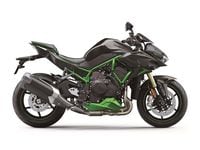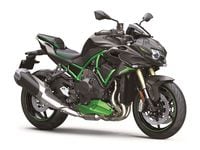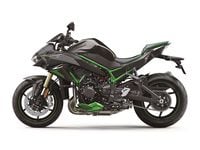Soon after upending the motorcycling landscape with the supercharged H2 and H2R, Kawasaki began dropping hints that it wasn’t finished with the forced-induction mayhem. In winter 2015, Kawasaki released drawings of two concept bikes using a “Balanced Supercharged Engine,” aimed less at monster peak power and more at torque. One concept drawing was called “SC-01 Spirit Charger” which showed a half-fairing on the bike; this eventually became the 2018 H2-SX sport-tourer. The other drawing was named “SC-02 Soul Charger” depicting a naked bike; and five years after the H2/H2R were dropped on the motorcycling public, the 2020 Z H2 made its debut.
By the time the Z H2 made its debut, the original H2′s power had been bumped up from 197 hp to 228 hp, leaving a nice little power space for Z H2 to slot into. While that 197 hp peak power number sounds great for a roadster, what will really get your attention is the claimed torque reading of 101 lb.-ft. at 8,500 rpm that is transmitted through an assist/slipper clutch and bidirectional (upshift and downshift) quickshifter. Testing the Z H2 SE for Cycle World, Doug Toland said: “To say it ‘peaks’ may actually be a bit misleading; the Z H2 has an almost electric torque feel starting from 2,000 rpm and basically adds 20 hp with every 1,000 rpm.” The term “warp speed” is bantered around a lot with bikes like this, but in the Z H2′s case it is truly apt. As Toland warned, “...make absolutely sure there is nothing in front of you.”
Thankfully the chassis and suspension are more than up to the task of controlling the engine power. The steel trellis frame is similar in build to the H2 SX, but with a beefy cast aluminum conventional swingarm rather than the single-sided units on the other H2s. Showa’s 43mm SFF-BP (Single Function Fork Big Piston) front fork and gas-charged rear shock handle suspension duties with excellent control, and the Z H2 SE ABS version that was released in 2021 adds Kawasaki Electronic Control Suspension (KECS) with Showa Skyhook EERA (Electronic Equipped Ride Adjustment) semi-active suspension technology. Slowing all that speed potential down are a set of Brembo’s top-shelf Stylema four-piston Monoblock calipers with steel braided brake lines with Kawasaki’s KIBS ABS adding a safety net without being intrusive.
The Z H2 SE ABS has a comfortable ergos that will handle 200-mile days without issue, although the upright riding position can get tiring battling the wind blast every time you decide to open up the throttle. It should also be noted that dipping into the boost frequently will have a negative effect on fuel mileage; as Toland noted in his Z H2 SE test, “I once saw 7 mpg—that’s seven—mpg.” But at a relative bargain price of $21,300, suffice it to say you’ll be having a lot of fun while doing it.
The 2024 Kawasaki Z H2 SE ABS is available in Metallic Matte Graphensteel Gray/Ebony/Mirror Coated Black for $21,300.



/cloudfront-us-east-1.images.arcpublishing.com/octane/KPFET4THGREKPGIMGTXYBAKKSA.jpg)
/cloudfront-us-east-1.images.arcpublishing.com/octane/323IPA4BLVDHFHVPJVC4YZBFDE.jpg)
/cloudfront-us-east-1.images.arcpublishing.com/octane/TJJICRFZSZEAHINLDFSTYVN5PU.jpg)
/cloudfront-us-east-1.images.arcpublishing.com/octane/FORIOJLCNZBONH6U3RPO5WLDN4.jpg)
/cloudfront-us-east-1.images.arcpublishing.com/octane/JUSPZP5FPBE4BDW372ZE7AZCQE.jpg)
/cloudfront-us-east-1.images.arcpublishing.com/octane/RJUQJTUY2BDOTEJCLAF5FKYVRE.jpg)
/cloudfront-us-east-1.images.arcpublishing.com/octane/BRYC3RKQIZDPBE237J37MFPF5Q.jpg)
/cloudfront-us-east-1.images.arcpublishing.com/octane/ANITOLZVDBBXHKXDJEBDFYHCCI.jpg)
/cloudfront-us-east-1.images.arcpublishing.com/octane/OVCONDHX65ESJN75JBZXD5D53E.jpg)
/cloudfront-us-east-1.images.arcpublishing.com/octane/QGTYXK4QOVGBHNHYJYY6O6HPXM.jpg)
/cloudfront-us-east-1.images.arcpublishing.com/octane/AZKRC3NTTRDPDO4X6INRBYRS3E.jpg)
/cloudfront-us-east-1.images.arcpublishing.com/octane/F6NSKOGUMVGPJLNTB53LYNH22A.jpg)
/cloudfront-us-east-1.images.arcpublishing.com/octane/UV2L2NVTDFA25PJ6OCJ5EIXAYM.jpg)
/cloudfront-us-east-1.images.arcpublishing.com/octane/HG3AVSFJFZHUHHECIC63PWTJDQ.jpg)
/cloudfront-us-east-1.images.arcpublishing.com/octane/6CP6VKBMDRHPNLH4JFYVW6DMCM.jpg)
/cloudfront-us-east-1.images.arcpublishing.com/octane/4FYW5AN7YVFZBMWPAZ6COUXJJ4.jpg)
/cloudfront-us-east-1.images.arcpublishing.com/octane/VUOTFUMRZBFILJ4TBSKYNRPZDM.jpg)
/cloudfront-us-east-1.images.arcpublishing.com/octane/A2TMJNBKPBEQJEF6PB2Q5PGQHM.jpg)
/cloudfront-us-east-1.images.arcpublishing.com/octane/4YLIEQ7HGBH4FNXXYONJYS5K7U.jpg)
/cloudfront-us-east-1.images.arcpublishing.com/octane/5BDFMBN2KJE7JNJK7LJ7EG4A2M.jpg)
/cloudfront-us-east-1.images.arcpublishing.com/octane/C3WGBZCFABC7XKBCFCCXDWYWME.jpg)
/cloudfront-us-east-1.images.arcpublishing.com/octane/PLQ5M7MG3RG7BHYH2OILWJZIPY.jpg)
/cloudfront-us-east-1.images.arcpublishing.com/octane/CCPZFYVVRBF2DLPMDYKPF4TMME.jpg)
/cloudfront-us-east-1.images.arcpublishing.com/octane/SIAXQ2ZOPNBYBLPKJPCHIYGG6A.jpg)